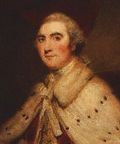William Fitzmaurice (from 1751 Petty) came from the Fitzmaurices, an Irish family who had been ruling the county of Kerry since the 12th century. He left Oxford in 1757 without taking a degree and became a military officer. He distinguished himself at the Battle of Minden (1759) and at Kloster Kampen (1760) during the Seven Years' War. After serving in the military, he was elected to the House of Commons (1760), but never sat there, succeeding to a seat in the Irish House of Lords as Earl of Shelburne (1764). He was a supporter of the Earl of Chatham, sharing many of his views and not placing much value on political party. Shelburne took over the leadership of Chatham's supporters after the death of Chatham in 1778. He assumed the post of Secretary of State for Home, Irish and Colonial Affairs (1782) in the short-lived administration of the Marquess of Rockingham, who died on 1 Jul 1782. Three days later (4 Jul 1782) Shelburne was appointed First Lord of the Treasury and became the head of a new administration. Some resignations ensued on his appointment, including those of Charles Fox and Lord John Cavendish. Shelburne formed a Cabinet with the best of talents rather than one of strong party allegiance, believing that ministers should be personally responsible to the Sovereign. The main issue for the Shelburne's administration was securing peace with the American colonists. Following sustained efforts by Shelburne, a provisional peace treaty was signed in Paris (13 Nov 1782), but its terms were rejected in the House of Commons by a small majority on 22 Feb 1783. Not having cultivated a supporting party in the Commons and with declining support from the King, he had to tender his resignation (24 Feb 1783), which was accepted on 26 Mar 1783. Biography source: [1, pp. 64-68]. |

